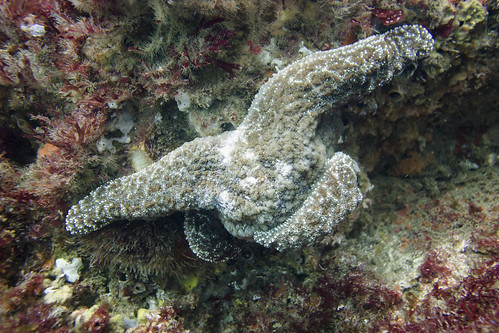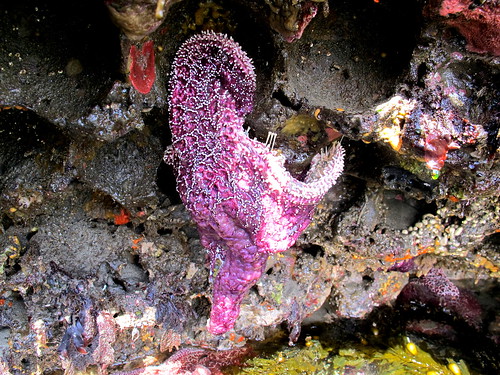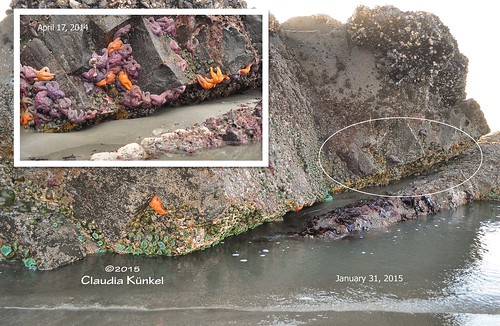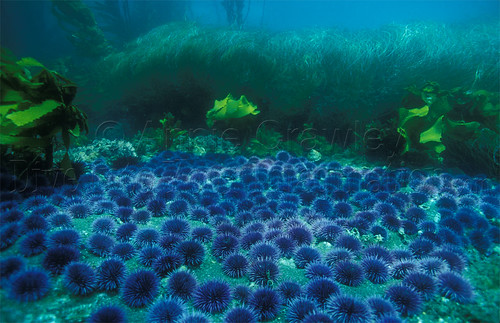 |
| image by Jonathan Martin |
So about two weeks ago I was in Seattle at the Sea Star Wasting Summit, hosted by the Seattle Aquarium!
This was an informal gathering of about 35-40 people who work on the west coast of North America, ranging from Alaska to Southern California to report on various aspects of Sea Star Wasting Disease (aka Starfish Wasting Disease aka Starfish/Seastar Wasting Syndrome).
The meeting brought together folks from a broad range of occupations that all have had some experience or contribution to our knowledge of the Starfish Wasting Disease phenomena: pathologists, veterinarians, ecologists, citizen scientists, aquarists, taxonomists, educators, and etc..
So, while I can't repeat everything that was discussed (some of it was still unpublished) here are some further insights...
What do we know?
1. Who? The disease seems to affect sea stars in the family Asteriidae most acutely. This includes Pycnopodia helianthoides (aka sunflower star), Pisaster spp (esp. P. ochraceus-the Ochre star), Evasterias troscheli (mottled stars) and Orthasterias koehleri (rainbow stars). Pycnopodia helianthoides, the sunflower star seems to have been one of the hardest hit...
but ultimately the disease seems to affect nearly every shallow-water seastar species on the Pacific west coast. So that includes leather stars (Dermasterias), Bat stars (Patiria), sun stars (Solaster) and so on...
There were a few species which showed much lower incidence of being infected but its unclear if that's simply an artefact (i.e. they aren't seen that often to begin with), less vulnerable, but there is really no further data...
 |
| Image from this article in Vice: http://www.vice.com/read/the-wasting-0000650-v22n5 |
 |
| map from http://data.piscoweb.org/marine1/seastardisease.html |
There is another "die off" event on the east coast but it has not been as thoroughly evaluated, so not sure. This 2012/2013 blog by Elena Suglia documents some of this phenomena
3. What? Symptoms of the disease of course are widely known and have been outlined in detail here at the UCSC Seastar Wasting page. The disease begins with white lesions and tissue necrosis (as shown below) and leads to "wasting" or "melting" of the body into an ugly pool of tissue and ossicles... But there's MUCH more to be seen at Seastarwasting.org in terms of characterization, etc.
There's a whole bunch of observations of these symptoms all over the internet Both from my prior blogs: Pycnopodia die off, and a further account here.. and many, MANY accounts of starfish wasting disease from Allison Gong's blog.
 |
| image by Allison Gong |
This is will likely be important in piecing together the actual cause of how the disease actually kills the sea stars, which remains poorly understood.
Challenges: figuring out what causes the disease is difficult and remains elusive.
So, by now many people have likely seen Ian Hewson et al.'s (2015) article showing identification of the Sea Star associated Densovirus (SSaDV) with the disease. Popularly reported here and in other news outlets..
This was an important first step. But its important to realize that we still do NOT KNOW that this is the actual CAUSE of the disease.
Probably one of the most important lessons I picked up from the meeting was how careful the work of disease pathologists needs to be.
Correlation is NOT Causation!
Powerful genetic tools have allowed us to characterize the SSaDV virus and experiments show that it is ASSOCIATED with the disease. But we have yet to identify exactly HOW Starfish Wasting Disease actually works. In other words, what actually happens to the animal to initiate death?
Just because we have this "disease associate" does not actually mean that it causes the disease.. it could simply be present with the disease as part of the suite of entities (e.g., bacteria, protists, etc.) taking advantage of the sick animals. Or it could be something already present that has become fouled or modified by some other factor.
My take away message was that MULTIPLE lines of evidence (genetics, tissue analysis, external observations, etc.) should all converge on the same conclusion. In other cases, pathologists are able to actually observe the agent (virus, bacteria, etc.) perform whatever action it takes to create the disease and thus the symptoms..
At this point, we are still working on what actually causes the "wasting symptoms" to occur. This is not to say we are clueless about it..but a definitive cause has not been shown.
One of the biggest issues we have right now? Understanding starfish biology.
A LOT of the study of invertebrate physiology went "out of style" in the 1960s along with a bunch of natural history research. There are many instances when we just don't understand what "normal" is for sea stars (or their relatives for that matter).
And so..the other powerful tool at play? Careful critical thinking..
(and yes.. what this means in the real world is that NO zombie or science fiction disease movie is likely EVER going to be solved in two hours!!)
What Tools are being used?
So now that I just got done saying a whole bunch of stuff about care and critical thinking, that is NOT to say that scientists are not throwing a whole arsenal of scientific tools at this problem to try and obtain as many different types of data as they can!
Dr. Felicia Nutter and student Eric Littman at Cornell University for example utilized sophisticated imaging techniques ranging from traditional X-rays to CT scans in order to look at the endoskeleton in afflicted sea stars, which it was thought, might be showing decreased skeletal density.
 |
| Image from http://phys.org/news/2016-01-imaging-technology-combat-disease-endangers.html |
Other tools include the Illumina technology sequencer which was used to investigate the phylogenomics of the virus and other microbes present in diseased individuals. Long story short: Tissue are taken from infected animals, recover DNA (or RNA) is extracted and purified, these machines sequence it (i.e., analyze it), and this permits identification of the organisms present. This was how the SSaDV (the sea star virus) was identified and characterized...along with the many other bacteria and other ambient forms living in/on the sampled sea stars..
These are among the many types of tools being applied..but there are certainly many more that fall into the more traditional roles: taking tissue samples, aquaria and freezers for living animals and tissue specimens
But as mentioned above, all roads should lead to Rome.. and with any luck, the results from these studies should all be consistent with one another...
Are there/Will there be Ecological Effects??
So, although a LOT of the attention both public and scientific is on the disease itself, many folks often forget that the after effects of the disease will also be very significant!
Sea stars such as Pisaster ochraceus and Pycnopodia helianthoides occupy very important roles in marine ecosystems. Called keystone species, their presence and/or absence as predators is thought to have a HUGE effect on the organisms around them.. (I wrote up a little of this on Pisaster here)
So what happens when those predators are suddenly gone??
There were no rigorous and statistical cases showing a clear "cause-effect" loss-of-predator-leads-to-increased-prey data presented. But in many cases there were anecdotal observations that "trophic cascades" might be starting... This one for example, allege that there has definitely been a shift in abundance of prey species..such as sea urchins as mussels.
That basically means that the loss of a predator triggers an increase in prey (here was an earlier blog post about urchin barrens).
which then results in some other ecological effects in the ecosystem.. say, a decrease in kelp coverage (resulting from urchin overfeeding) which in turn results in the loss of kelp-inhabiting species and so forth and so on....
Some scientific observations suggest that we might be seeing some of this.. but not necessarily everywhere. Environments across the coast vary.... so what you see in some parts of California might NOT be the same situation in some protected cover in Oregon....
Time, further data and experiments will tell..
Some scientific observations suggest that we might be seeing some of this.. but not necessarily everywhere. Environments across the coast vary.... so what you see in some parts of California might NOT be the same situation in some protected cover in Oregon....
Time, further data and experiments will tell..
1. Are all the starfish on the coast extinct? Is my favorite species (e.g., Pycnopida, Pisaster, etc.) extinct??
In NO instance is ANY of the species surveyed thought to be completely extinct. Some individuals and news agencies have either misreported or exaggerated the the impact of the disease. MANY populations have been decimated. Localized populations have been wiped out...but there STILL are healthy populations of all afflicted sea stars species.
So, some species are "locally extinct" which means that you might not see any at your favorite local rock pool or pier but there's no evidence for complete and total extinction.
2. What about the juveniles we are seeing?
There are many reports (such as this one in Nat Geo and this one in the OregonLive) of smaller individuals of various species, Pisaster, Pycnopodia, etc. being seen widely along the west coast where adult starfishes have been wiped out by SSWD.
There were MANY reports of these out in the intertidal zones along the coast. The significance of the juveniles is unclear at this point. Possible reasons and questions as to why we are seeing them:
- They are now more obvious because the adults are gone (and we are looking)
- They have become more bold because the adults are gone.
- Are there more of them present now because of absent adults?
- How fast do they grow? Will they enter in the former adults ecological setting?
If you see any, you can report them to the Seastar Wasting Website here.
You can download a nifty GUIDE to identifying tiny juvenile sea stars HERE.
3. Is the worst over?
Yes. It seems to be, but mainly because most of the adults which carried the disease are themselves all gone. Its unclear what factors are at play insofar as why some populations have been more heavily hit than others.
4. Do Any of the standard aquarium antibiotics work?
Many of the standard aquarium drugs (antibiotics, etc.) seem to be most effective against the secondary bacterial infections which attack the animals after becoming sick. But unfortunately, they don't seem to curtail the actual disease much if at all.
5. Is Climate Change/Temperature a factor?
I would say yes. And others would agree with me (here). There have been several informal experiments and observations of seasonality which suggest that higher water temperature is, at least, significant and worth investigating as a factor. But, at the time of this writing, a clear paper has not been published which establishes a rigorous link.
6. Is the wasting disease caused by Fukushima/Republicans/Democrats/Cthulhu/Extraterrestrials/ Atlantis/Inner dimensional beings from the 7th Parallel?
Nope. Not even a little.
My thanks to Lesanna Lahner, Ian Hewson, Melissa Miner and the other participants at the Sea Star Wasting Symposium!
Standard caveat: i've done my best to represent a LOT of information. Any mistakes are my own.
Further Resources:
The Sea Star Wasting Site at UCSC:
http://www.eeb.ucsc.edu/pacificrockyintertidal/data-products/sea-star-wasting/
Ian Hewson's blog about SeaStar Microbial Ecology: https://seastarwastingdisease.wordpress.com/
iNaturalist: Tracking Sea Star Wasting Disease:
http://www.inaturalist.org/projects/pisaster-disaster-tracking-starfish-wasting-disease
A useful summary page from Sanctuary Integrated Monitoring Network (SIMoN)
http://sanctuarysimon.org/projects/project_info.php?projectID=100401








11 comments:
Thanks for the update, this was very helpful. Do any of these species brood and, if so, is it expected that they would have a slower recovery from a massive die off?
thanks for your interest.
Leptasterias is the only one of the known species in the affected area that broods. Fatality and recovery of all the species is poorly understood. Absence of information on Leptasterias is in part due to the fact that it is smaller than the other species. Some work is being done but as yet nothing is published.
I live on Quartermaster Harbor, Vashon Island, in Puget Sound. The beach for at least half a mile is packed with sand dollars, alive and dead. Stacked like oreos, three layers deep. Easily 100/sq ft. I have only lived here for 2 years, so I don't know if the population was like this prior to wasting disease, but it doesn't seem healthy. Has anyone else seen a population jump in sand dollars since predator sea stars are gone? I have only seen one star fish in this area.
Yes. that sounds normal. That's Dendraster excentricus which is a filter feeding sand dollar on the Pacific west coast. Its not unusual to see them in high abundance. This video shows them in Laguna Beach
https://www.youtube.com/watch?v=xkTrru9Ew_E
this is pretty normal.
Greetings,
I've got three comments:
1. SSWD and climate change - recently a paper came out that purported to show a link between warming and SSWD. That paper seemed to me to be seriously flawed in its conclusions which were based on a geographically limited data set and ignored conflicting data from nearby areas. Had the researchers used data from the entire region (easily available) their conclusion would have been negated if not completely reversed. While warming 'could' be having an effect on SSWD I have yet to see intellectually rigorous work showing any linkage.
2. SSWD and brooding - At the Feiro Marine Life Center in Port Angeles, WA during 2014 we lost approx. 80% of our large species stars and approx. half that proportion of our small species stars, including Leptasterias. We have enjoyed successful Leptasterias breeding in our facility for the past 8 or 9 years and this has continued post SSWD at a rate consistent with our reduced population. The resulting offspring are left to forage on their own with no attempt made at supplemental feeding. Post SSWD we have noticed a slightly higher survival rate and, in some cases, a dramatically higher growth rate. The data set is far too small for a rigorous analysis but it does appear that reduced competition may be helping with juvenile development.
3. Sand Dollar accumulations - As Chris said, sand dollars can be incredibly abundant in parts of Puget Sound; far more so than in the linked video. Further, it's pretty common for non-living things to be concentrated on certain beaches by wind, waves, and current (dead sand dollars, crab molts, sea lettuce, etc.). That said, the assertion of numbers like 100 per square foot that include both living and dead individuals is noteworthy - I can't remember ever seeing a live Dendraster washed ashore. I would suggest getting some photo documentation that includes density, extent, and proportion of live to dead specimens; share it here and with local experts (University of Washington, Seattle Aquarium, etc.).
I am doing a report on the Eccentric Sand Dollar of Puget Sound and so far I have not found any reliable websites for a question I have that has almost no answers. The question is, how much do the predators of the Sand Dollar affect their population? So far I have not found anything and would love to hear your response. This project is to help protect the Sand Dollar population of Puget Sound so it is for a good cause. Thanks!
I would type "Dendraster excentricus predation" into Google Scholar. Some papers should pop right up!
Thanks!
Here at the Leahy Center in Burlington, Vt. our sea stars (asterias forbesi) seem to be suffering from something that visually looks exactly the same as SSWS, but it is taking months for the sea stars to die and they are subccuming one at a time.
Is there any info you could share about this?
Thanks, Barry
Hi Barry,
Okay. It took me a moment to realize that your stars are actually in aquaria since your education center is on a lake. Its not unusual for sea stars to develop bacterial infections, encounter stress or develop some kind of mild version of "wasting disease" while they are in captivity. This could be a wide variety of issues ranging from water quality, temperature, etc. It also depends on whether or not they are being used for "touch pool" type education encounters.
It depends.
Hi Barry,
I am looking for video or still images on diseased star fish for a short video I producing on passionate ocean advocates.The first in our series is on an tide pool educator/musician who discusses sea star wasting disease. I saw two detailed images on your blog by Johnathan Martin but have not been able to track him down for permissions to use his images. Can you forward my contact info or send me his? I'd appreciate your help or if you have access to any other images that would be perfect.
Thanks for any help in advance.
Cynthia Abbott
Post a Comment